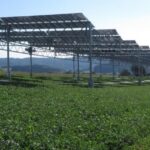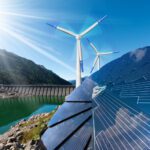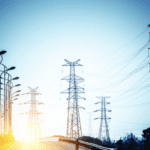Billions of dollars are supporting renewable energy development in the U.S. The International Energy Agency has said record amounts of spending on clean energy will increase global energy investment by 8% in 2022.
Julie McLaughlin, a managing director with Alvarez & Marsal’s U.S. Energy practice in San Francisco, California, has extensive experience in the energy space, working with utilities, private equity, and renewable project developers and regulators. She recently conducted a market study as part of a team advising Harbert Infrastructure in the $400 million strategic financing relationship closed with D.E. Shaw Renewable Investments. The study established the total addressable market for renewables in the U.S. and mapped out the renewable development landscape.
McLaughlin, who has worked across 16 countries in North America, Latin America, Europe and Asia, recently provided POWER with her insights on where platforms for renewable development are headed.
POWER: What should utilities be doing right now to transition from thermal generation to renewables? Or should they transition at all?
McLaughlin: The vast majority of U.S. utilities have already started down the energy transition journey and countless utilities have made net-zero commitments by 2050. These aren’t just utilities on the coasts in states with climate-focused policies, but also utilities in the Midwest and Southeast that rely significantly on coal and gas generation. For example, Ameren, which is headquartered in St. Louis, recently moved its net-zero commitment up to 2045 and pledged the retirement of 3,500 megawatts (MW) of coal by 2030.

In some cases, a U.S. utility’s commitment to net-zero is motivated by shareholder pressure, but in others, costs are influencing the shift. In late August, the Wall Street Journal reported that electricity bills in West Virginia have been increasing more than other states due to $383.5 million in upgrades made to the state’s coal generation fleet. Between rising commodity prices and expensive maintenance, fossil fuel plants are less competitive against renewables than they used to be.
While some fossil fuel generation may be required for reliability in certain jurisdictions, the integration of renewables, which do not pay for fuel, is in the best economic and environmental interests of ratepayers.
POWER: Coal burn may set a record in 2022, in part due to increased use in Europe due to Russia’s invasion of Ukraine. What does this mean for the rollout of renewables in Europe and perhaps elsewhere in the world? Will such geopolitical actions slow the growth of renewable energy?
McLaughlin: Power generation is very locational-specific. As widely reported, the war in the Ukraine has severely impacted the supply of natural gas in Europe and those supply constraints have broad-sweeping consequences. That said, I do not expect the current disruptions to stymie the rollout of renewables in the long run. If anything, the gas constraints have accelerated European incentive programs for the development of alternative liquid fuels like hydrogen.
POWER: What is your opinion of reliability concerns about renewable energy? Whether warranted or not, many continue to argue that wind and solar are not reliable enough to replace baseload power from thermal plants—are those arguments valid?
McLaughlin: Reliability is essential to any electric grid and the ratepayers who rely on its services. In the U.S., we have seen the consequences of insufficient reserve margin in both CAISO and ERCOT. Certain electric grids, which have sufficient baseload renewable resources like hydroelectric and geothermal, are reliably serving their customers with 100% or close to 100% renewable power. For the electric grids without baseload renewables, it will take investment and innovation as well as time to transition to 100% renewable.
What many people don’t realize is that the consumption of primary energy, as well as electricity production, has been variable since its inception. At the turn of the twentieth century, coal represented more than 90% of global primary energy consumption, which was later overtaken by oil, gas and nuclear. In March of this year (2022), U.S. wind production surpassed both coal and nuclear for the first time.
I am optimistic about society’s ability to transition to reliable, net-zero electricity over time. In addition to conventional renewables, the transition likely involves next-generation nuclear as well as hydrogen and possibly other technologies not yet commercially proven.
POWER: The first challenge for any power generation project to move forward is to find financing. What is the first step (and/or subsequent steps) that an entity should take when considering a renewable energy project?
McLaughlin: In my experience, formal financing (permanent equity and debt), is one of the last steps in the development of a renewable energy project. The first step is to secure site control of a location with compelling project attributes (resource availability, proximity to the electric grid in a region with transmission capacity, favorable geographical and geological conditions, etc.). Once site control has been achieved, the developer embarks on a multi-year process of permitting and interconnect (to grid). The duration and capital requirements of permitting and interconnect vary broadly between jurisdictions but can as long as five or six years in certain U.S. states. As a project gets closer to obtaining all the key permits as well as an interconnection agreement, the project developer general turns their attention to power/environmental attribute offtake and equipment supply/construction. With all those elements in place, securing financing becomes one of the easier steps in the development process.
POWER: What are the major challenges facing renewable energy today, and how do those challenges impact different technologies (solar, onshore wind, offshore wind, battery storage, etc.)?
McLaughlin: In the U.S., the most significant challenges facing renewable energy are overrun interconnection queues to connect to the grid and supply chain constraints. Interconnection delays generally impact all renewable technologies equally, with the exception of behind-the-meter solar and energy storage, which benefit from straightforward processes with the local utilities because of their proximity to load. Supply chain constraints vary. The solar market in the U.S. was hamstringed earlier this year by the Department of Commerce’s inquiry into whether solar panels from Southeast Asia were circumventing anti-dumping rules. Wind and energy storage have had their own challenges as well.
POWER: Environmental arguments for renewable energy are obvious, but are there financial arguments that can bring about more support for renewables?
McLaughlin: On the basis of levelized cost of energy, which takes into consideration capital expenditure (CAPEX), operational expenditure (OPEX) and fuel costs, wind and solar in the U.S. are on par with combined-cycle generation both with and without tax credits. The optimal mix of generation technologies will depend largely on resource availability in a specific jurisdiction. That said, given the competitive costs of renewable power, doubling down on fossil fuels as West Virginia has done with coal, is unlikely to lead to an economically attractive outcome.
—Darrell Proctor is a senior associate editor for POWER (@POWERmagazine).










